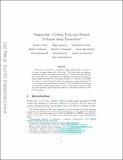| dc.contributor.author | Abel, Zachary | |
| dc.contributor.author | Akitaya, Hugo | |
| dc.contributor.author | Chiu, Man-Kwun | |
| dc.contributor.author | Demaine, Erik D | |
| dc.contributor.author | Demaine, Martin L | |
| dc.contributor.author | Hesterberg, Adam | |
| dc.contributor.author | Korman, Matias | |
| dc.contributor.author | Lynch, Jayson | |
| dc.contributor.author | van Renssen, André | |
| dc.contributor.author | Roeloffzen, Marcel | |
| dc.date.accessioned | 2022-07-22T14:46:35Z | |
| dc.date.available | 2022-07-22T14:46:35Z | |
| dc.date.issued | 2021 | |
| dc.identifier.uri | https://hdl.handle.net/1721.1/143963 | |
| dc.description.abstract | Compilation copyright © 2017 Michiel Smid Copyright of individual papers retained by authors.All right reserved. We study Snipperclips, a computer puzzle game whose objective is to create a target shape with two tools. The tools start as constant-complexity shapes, and each tool can snip (i.e., subtract its current shape from) the other tool. We study the computational problem of, given a target shape represented by a polygonal domain of n vertices, is it possible to create it as one of the tools' shape via a sequence of snip operations? If so, how many snip operations are required? We show that a polynomial number of snips suffice for two different variants of the problem. | en_US |
| dc.language.iso | en | |
| dc.publisher | Elsevier BV | en_US |
| dc.relation.isversionof | 10.1016/J.COMGEO.2021.101784 | en_US |
| dc.rights | Creative Commons Attribution-NonCommercial-NoDerivs License | en_US |
| dc.rights.uri | http://creativecommons.org/licenses/by-nc-nd/4.0/ | en_US |
| dc.source | arXiv | en_US |
| dc.title | Snipperclips: Cutting tools into desired polygons using themselves | en_US |
| dc.type | Article | en_US |
| dc.identifier.citation | Abel, Zachary, Akitaya, Hugo, Chiu, Man-Kwun, Demaine, Erik D, Demaine, Martin L et al. 2021. "Snipperclips: Cutting tools into desired polygons using themselves." Computational Geometry: Theory and Applications, 98. | |
| dc.contributor.department | Massachusetts Institute of Technology. Department of Electrical Engineering and Computer Science | |
| dc.contributor.department | Massachusetts Institute of Technology. Computer Science and Artificial Intelligence Laboratory | |
| dc.relation.journal | Computational Geometry: Theory and Applications | en_US |
| dc.eprint.version | Author's final manuscript | en_US |
| dc.type.uri | http://purl.org/eprint/type/JournalArticle | en_US |
| eprint.status | http://purl.org/eprint/status/PeerReviewed | en_US |
| dc.date.updated | 2022-07-22T14:34:32Z | |
| dspace.orderedauthors | Abel, Z; Akitaya, H; Chiu, M-K; Demaine, ED; Demaine, ML; Hesterberg, A; Korman, M; Lynch, J; van Renssen, A; Roeloffzen, M | en_US |
| dspace.date.submission | 2022-07-22T14:34:34Z | |
| mit.journal.volume | 98 | en_US |
| mit.license | PUBLISHER_CC | |
| mit.metadata.status | Authority Work and Publication Information Needed | en_US |
